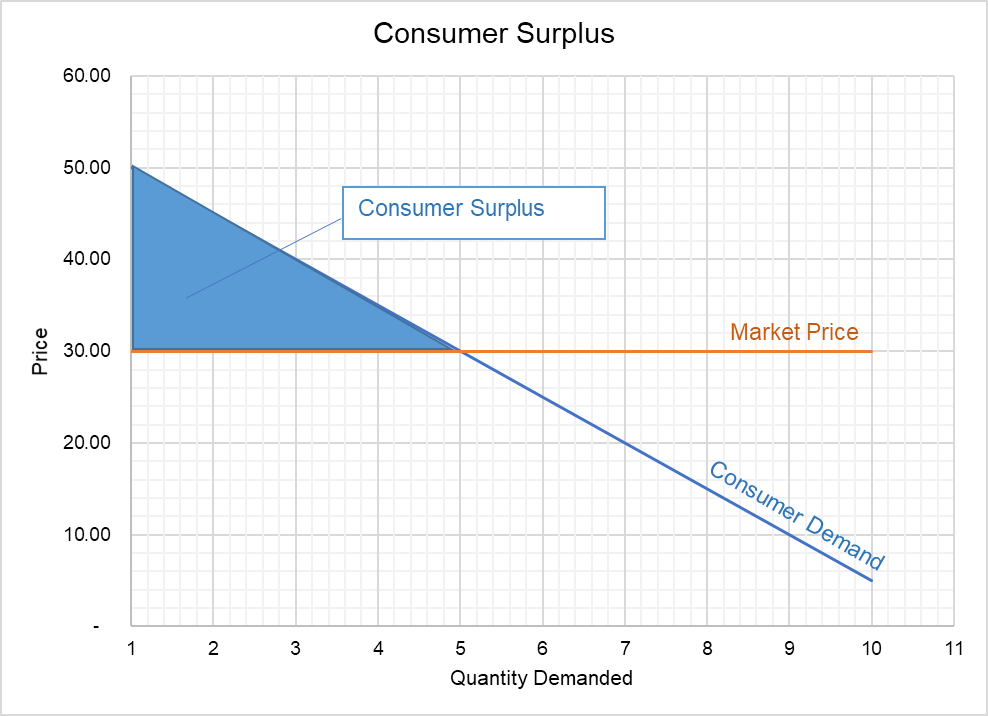Consumer Surplus
Consumer surplus represents the difference between total utility of a good and its market cost. It equals the cumulative difference between the amount consumers are willing to pay for a good and the amount they pay in the market.
Consumer surplus can be worked out by adding up the price consumers are willing to pay for first, second, third and nth unit of a good and subtracting the n times the market price of the good. It can be mathematically expressed as follows:
$$ \text{CS} =\ \text{P} _ \text{1}+\text{P} _ \text{2}+\text{P} _ \text{3}+\text{...}+\text{P} _ \text{n}-\ \text{n}\times \text{P} $$
Where CS stands for consumer surplus, P1, P2, P3 and Pn are the prices the consumer is willing to pay for the first, second, third and nth unit, n is the equilibrium number of units and P is the market-clearing price.
The law of diminishing marginal utility states that the benefit that consumers derive from each additional unit of a good is lower than the benefit obtained from the unit preceding it. It means that the consumers are willing to the highest for the first unit, second highest for second unit and so on. But what they eventually pay for the number of units they need is a single price i.e. the market clearing price. Consumer surplus arises due to this cumulative difference between the marginal utility of each unit and its ultimate cost to the consumer.
Let’s consider Steve who is an avid moviegoer. The following table shows an indication of marginal utility of movies he watches in each month:
| Movie No. | Price |
|---|---|
| 1 | 50.00 |
| 2 | 45.00 |
| 3 | 40.00 |
| 4 | 35.00 |
| 5 | 30.00 |
| 6 | 25.00 |
| 7 | 20.00 |
| 8 | 15.00 |
| 9 | 10.00 |
| 10 | 5.00 |
The price that prevails in the market is one in which the demand curve and the supply curve intersects. Let’s say that the market clearing price is $30. At this price, Steve will watch 5 movies paying a total of $150 (i.e. 5 movies multiplied by market price of $30). It is because Cinemas can’t charge him $50 for first unit, $45 for second unit and so on. Steve’s surplus in this case equals $50 i.e. the cumulative difference between marginal utility of each unit and the market value (i.e. Q × P).
The following graph shows Steve’s consumer surplus:

Just like consumer’s benefit from the difference between the marginal utility of the units they consume and the market price, producers also benefit from participating in the market. Supply curves are generally upward sloping which means that the producers are willing to offer each additional unit at progressively higher price. But since they get the same market clearing price for all units, the money they receive is ultimately higher than the sum of the prices at which they were willing to provide those units. This difference is called producer surplus.
Consumer surplus is an important concept in consumer behavior analysis. As soon as the consumer surplus is positive, it is beneficial to participate in the market. Consumer surplus is also useful in studying the detrimental effect of different market interventions (price floors, price ceilings, etc.) and different market imperfections (i.e. monopolies, etc.).
by Obaidullah Jan, ACA, CFA and last modified on